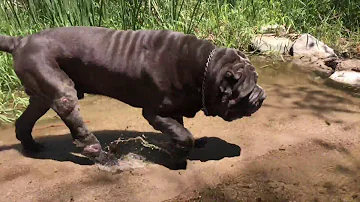
Neapolitan Mastiff
Canis lupus familiaris

Meet the Neapolitan Mastiff
The Neapolitan Mastiff is a massive, ancient breed of domestic dog known for its loose, wrinkled skin, heavy jowls, and imposing presence. Originally bred in southern Italy as a guard and war dog, it is famous for its protective instincts and loyalty to its family. Despite its intimidating appearance, the Neapolitan Mastiff is often gentle and affectionate with its owners, displaying a calm yet watchful demeanor. Its thick, loose skin and folds serve as natural protection, and the breed is characterized by its lumbering gait and powerful build.
Classification
Mammal
Habitat
Domestic (Human environments)
Diet
Carnivore
Lifespan
7-9 years
Conservation
Least Concern
Weight
50–70 kg (110–154 lbs)
📖Fascinating Facts
Ancient Origins
The Neapolitan Mastiff descends from the ancient Molossus dogs used by the Romans for guarding and war over 2,000 years ago.
Protective Guard Dog
This breed was specifically developed to guard property and families, making it naturally wary of strangers but deeply devoted to its owners.
Unique Appearance
Their extensive wrinkles, loose skin, and heavy folds are not just for looks—they help protect the dog in case of attack by providing extra layers.
📋Detailed Description
The Neapolitan Mastiff (Mastino Napoletano) is a giant, molossoid breed notable for its massive, muscular frame and distinctive loose, heavily wrinkled skin, particularly around the head, neck, and chest. Adult males typically stand 65–75 cm (26–30 in) at the withers and weigh 60–70 kg (130–150 lb), while females are slightly smaller at 60–68 cm (24–27 in) and 50–60 kg (110–130 lb). The breed's broad, flat skull, pronounced stop, and deep-set eyes give it a solemn, imposing expression. Its short, dense coat is most commonly lead-grey, blue, black, or mahogany, with brindle and tawny also recognized. The Neapolitan Mastiff's anatomy is adapted for power rather than speed, with a deep chest, thick neck, and robust limbs supporting a lumbering, deliberate gait. Behaviorally, it is calm and steady, displaying a natural wariness of strangers but deep loyalty and affection toward its family. Socially, Neapolitan Mastiffs are often solitary or form strong bonds with a single person or household, showing protective instincts that make them excellent guardians. Reproductively, the breed tends to have small to moderate litter sizes (6–12 puppies), with a gestation period typical of large dogs (about 63 days). Unique adaptations include their thick, pendulous skin, which historically provided protection from bites or blows, and their low, rumbling vocalizations used for communication and deterrence.
💡 Did you know?
Neapolitan Mastiffs were featured as the breed of Hagrid's dog, Fang, in the Harry Potter film series.
🔬Research & Sources
Wikipedia Summary
The Neapolitan Mastiff or Mastino Napoletano is an Italian breed of large dog of mastiff type. It was recognised as a breed by the Ente Nazionale della Cinofilia Italiana in 1949, and accepted by the Fédération Cynologique Internationale in 1956.
Last Modified: 2/28/2025
🎭Behavior & Social Structure
Neapolitan Mastiffs are primarily sedentary, preferring to conserve energy and remain close to their territory or family. They are not highly active, but will patrol their home and respond rapidly to perceived threats. Their feeding behavior is typical of large domestic breeds, requiring a high-calorie diet to maintain muscle mass, though they are prone to obesity if overfed. Social interactions are characterized by strong attachment to owners and aloofness or suspicion toward strangers and unfamiliar animals. They are generally tolerant of children and other pets when properly socialized, but their size and strength require careful supervision. Daily routines include periods of rest interspersed with brief, purposeful activity, such as alerting to visitors or patrolling the yard. Neapolitan Mastiffs communicate through body language, deep barks, and low growls, relying on their imposing presence rather than aggression to deter intruders.
👶Reproduction & Life Cycle
Neapolitan Mastiffs reach sexual maturity at approximately 18–24 months. Females typically come into estrus twice a year, with no strict breeding season due to their domestic status. Courtship involves scent marking and close physical contact, with males often displaying protective behaviors toward receptive females. The gestation period averages 63 days, after which litters of 6–12 puppies are born. Neonates are altricial, requiring intensive maternal care; mothers are attentive, providing warmth, grooming, and feeding. Weaning begins at 3–4 weeks, with puppies gradually transitioning to solid food by 6–8 weeks. Breeding is often managed to minimize health risks, as the breed is prone to dystocia (difficult births) due to large head size and body mass.
🛡️Adaptations & Survival
The Neapolitan Mastiff's most notable physical adaptation is its thick, loose, and heavily folded skin, which historically protected vital areas during combat or when guarding property. The breed's massive musculature and robust skeletal structure provide formidable strength and deterrence. Its deep, resonant bark and imposing size serve as effective warning signals, reducing the need for direct confrontation. Behaviorally, the breed has evolved a calm, steady temperament, enabling it to remain vigilant without unnecessary aggression. Its low activity level conserves energy, an advantage for a large-bodied animal. The breed's acute hearing and olfactory senses further enhance its guarding abilities.
📚Research Sources
🎨Cultural Significance
The Neapolitan Mastiff has deep roots in Italian history, believed to descend from the Roman Molossus war dogs used in battle and as guardians of estates. The breed is emblematic of southern Italian culture, particularly Naples, where it has been celebrated in art, literature, and folklore as a symbol of strength, loyalty, and protection. Historically, Mastini were used to guard property, livestock, and even as gladiatorial dogs. In modern times, the breed has appeared in films and media, notably as 'Fang' in the Harry Potter series, further cementing its iconic status. The Neapolitan Mastiff is also associated with traditional Italian values of family and home defense.
🔬Recent Research & Discoveries
Recent scientific studies have focused on the genetic diversity of the Neapolitan Mastiff, revealing a relatively narrow gene pool compared to other mastiff breeds, which raises concerns about inherited disorders. Veterinary research has examined the prevalence of orthopedic and dermatological conditions, leading to improved screening protocols for breeding stock. Ongoing studies are investigating the breed's temperament and suitability as a therapy or service animal, given its calm demeanor. Advances in canine genomics may offer new insights into the breed's ancient lineage and relationship to other molossoid dogs. Conservation efforts by breed clubs emphasize health testing, responsible breeding, and public education.
🎥Wildlife Videos

Wild Neapolitan Mastiff (Mega Thee PHD)
Here is another video of our boy Mega chilling in the local stream enjoying the wild life. We hope you enjoy this video please like ...
Mastinos Del Manicomio

THE NEAPOLITAN MASTIFF - HUGE & DANGEROUS GUARD DOG? Mastino Napoletano
Anneka meets one of the World's most famous Italian Guard Dog breeds descended from the huge Roman Molosser dog. Known ...
Animal Watch

THE SWISS ALPS | Secrets of the Apex Hunters | Animal documentary
Welcome to the majestic Swiss Alps, a breathtaking wilderness that's home to some of the most extraordinary apex predators on ...
WILD NATURE - Nature animal documentary

The Silent Killer Facing The Ultimate Guardian Dog Of Tibet | Tibetan Mastiff vs Snow Leopard
Tibetan Mastiff vs. Snow Leopard In the rugged, high altitude wilderness of the Himalayas, Snow Leopard reign The silent hunter ...
HB Kennel

The Baltic | Survival in a Pristine Ecosystem | Animal documentary
Welcome to "The Baltic | Survival in a Pristine Ecosystem", a captivating wildlife documentary that transports you to the serene yet ...
WILD NATURE - Nature animal documentary

Neapolitan Mastiff vs Dogo Argentino | Animated | Wildlife Documentary | Informative #biography
Neapolitan Mastiff vs Dogo Argentino | Animated | Wildlife Documentary | Informative #biography ...
Animals World.official
🌍Habitat Information
The Neapolitan Mastiff typically inhabits Domestic (Human environments) environments. Neapolitan Mastiffs have adapted to their environments with specialized features and behaviors.
Primary Habitat:
Domestic (Human environments)
More detailed habitat information will be available soon.
🛡️Conservation Status
The Neapolitan Mastiff is currently classified as Least Concern. Conservation efforts are crucial for preserving this species for future generations.
Common Threats:
- 🏠Habitat loss and fragmentation
- 🌡️Climate change impacts
- 🎯Hunting and poaching
- 🏭Human-wildlife conflict
⚠️Threats & Conservation Challenges
While the Neapolitan Mastiff is not threatened in the wild, the breed faces significant challenges related to health and population management. Common health issues include hip and elbow dysplasia, cardiac problems, entropion (inward-turning eyelids), and skin infections due to deep folds. The breed's large size and rapid growth can exacerbate orthopedic conditions. Inbreeding and a limited gene pool have led to concerns about genetic diversity, especially outside Italy. Responsible breeding practices are essential to mitigate hereditary diseases. Human impact includes overbreeding for appearance rather than health, and abandonment due to the breed's demanding care requirements. Population trends remain stable in Europe and North America, but responsible ownership and education are critical for breed welfare.
🔬Scientific Classification
Scientific Name
Canis lupus familiaris
Classification Hierarchy
🔍 About Taxonomic Classification
Taxonomic classification is a hierarchical system used by scientists to classify and organize living organisms based on shared characteristics and evolutionary relationships.
The system moves from broad categories (Kingdom) to increasingly specific ones, with each animal's scientific name typically consisting of its Genus and species.
📝Community Notes
Share your observations and insights about the Neapolitan Mastiff with our community of wildlife enthusiasts.
Join Our Community
Sign in to share your observations and connect with fellow wildlife enthusiasts.
Sign In to ContributeNo community notes yet
Be the first to share your observations about the Neapolitan Mastiff!
Explore Neapolitan Mastiff
Select a tab above to learn more about this amazing animal.
📸Photo Gallery
No photos available for this animal yet.
🌟Discover More Wildlife
Continue your journey of discovery with more fascinating animals from our database
